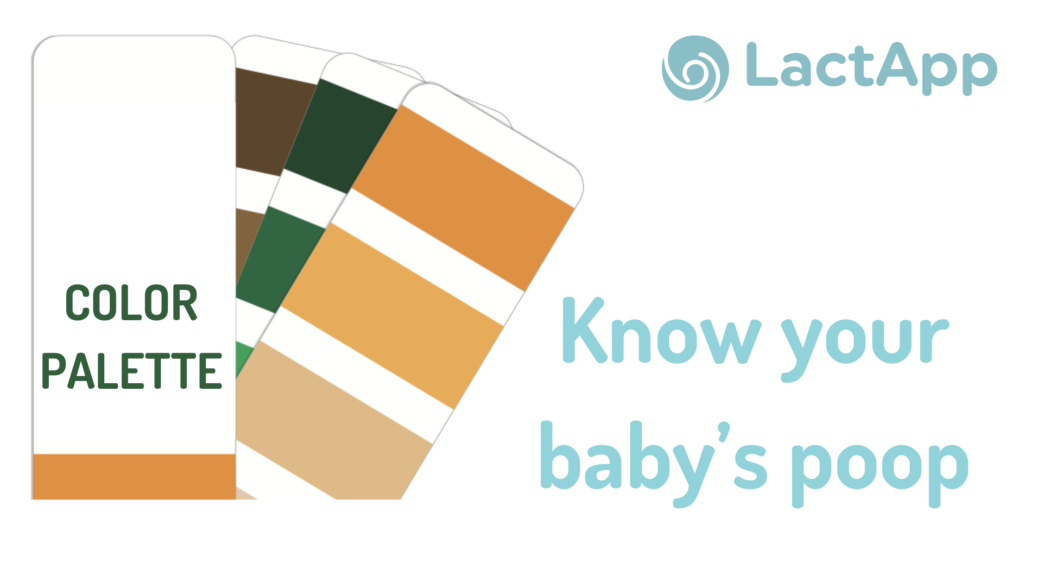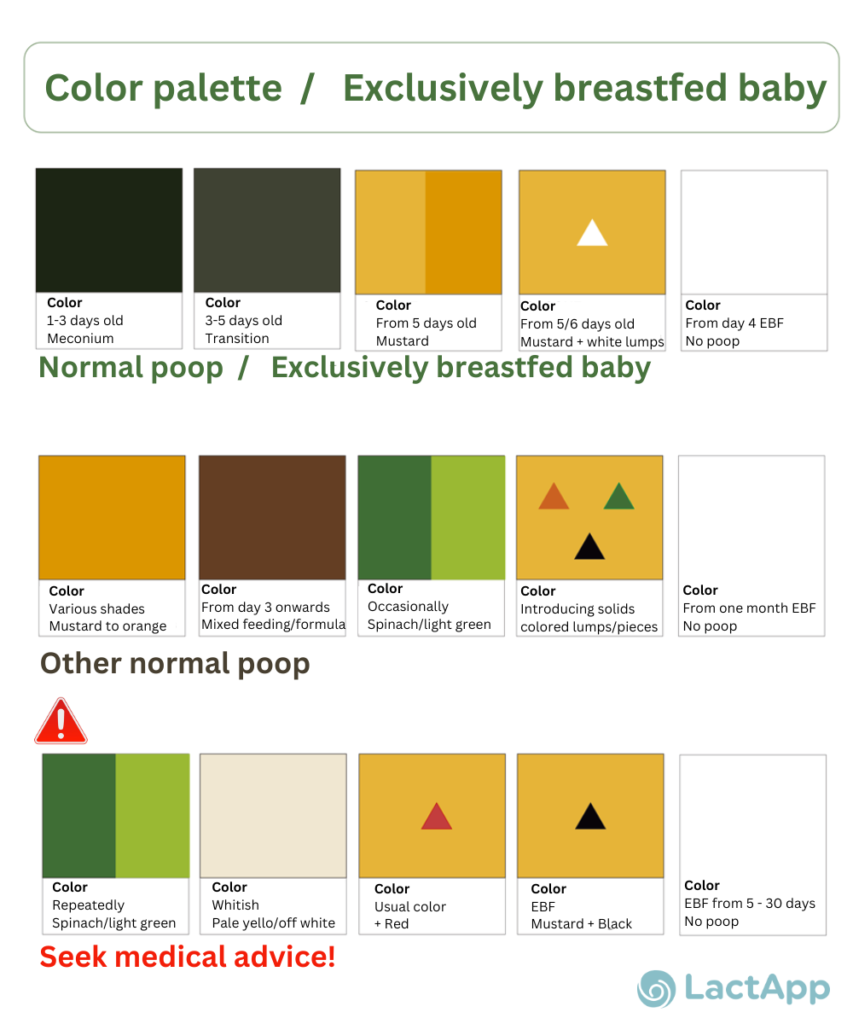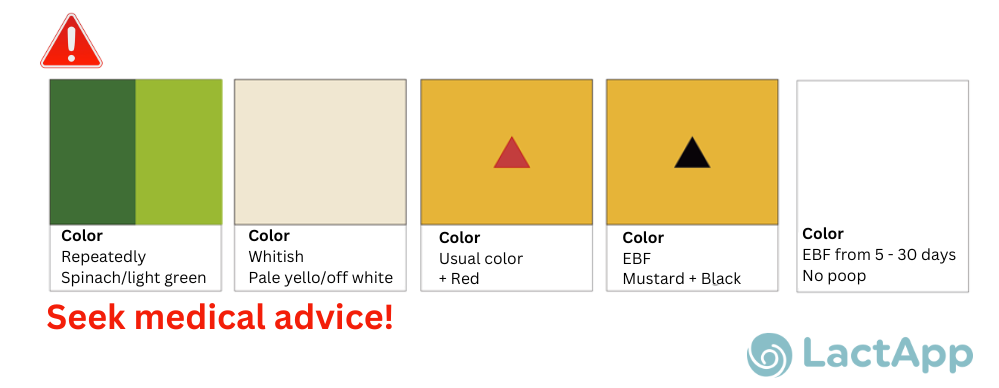
Breastfed baby poop: the color palette
Families are often worried about their baby’s poop when they have a newborn: about appearance, smell, texture and amount of poop.
When first getting into the wonderful world of baby poop, we realize that there is a huge palette of possible colors that makes you doubt each change of color, so here we explain one by one each of the possibilities with this color “palette” of poop.
It may seem unbelievable, but from the first week after birth, baby poop can have a wide variety of shades and appearances, so let’s see them.

First days
The first stools are called meconium; they are the remains of amniotic fluid that babies ingest while they are in the womb. Meconium is black and very sticky and is expelled during the baby’s first three days. It is usual for your baby to soil two diapers on the first day, two or three on the second day, and two or three more on the third day of their life.
The more colostrum they have, the faster they will get rid of all the meconium, which prevents babies from getting jaundice.
Once all the meconium has been expelled, the next poop is called the “transition” stool. This poop usually appears between the 4th and 5th day of life. It is grayish-green poop with mustard-colored specks. These poops tell us that your baby has already had some mature breast milk.
Sometimes, babies do not poo on their 4th or 5th day of life. This may be normal, but make sure your baby is hydrated and continues to wet diapers with clear urine.
Finally, after the transition poop, between the 5th and 6th day of life, the typical poop of exclusively breastfed babies appears. They are of an orange mustard color, sometimes with white specks. During the first month, babies should do more than two poops a day, ideally one after each feed. This tells us that they receive plenty of breast milk and, therefore, they gain weight correctly.

From the first week onwards
You open the diaper and find green poop… what on earth is that?
Don’t worry; the occasional green poop is nothing to worry about; the typical mustard-colored poops can oxidize after a while and turn greenish, which can be confusing.
Only when the baby has many green stools and shows discomfort might it be that they have too much lactose, which can complicate their digestion.
Brown color: a single feed of formula milk can change the baby’s bacterial flora and cause the texture, odor, color, and quantity of stools to change. When this is the case, poops are no longer a reliable element to assess whether a baby is feeding properly.
Another thing that can also happen is that babies don’t poop at all.
How long can a baby go without pooping?
From the first month of life, exclusively breastfed babies stop having several bowel movements a day and have them irregularly, sometimes even taking many days to have a bowel movement. However, the fact that it takes them several days to have a bowel movement does not mean they have constipation if they still have liquid and plentiful bowel movements when they do.
On the other hand, if you are mixed/combo feeding or formula feeding, constipation is possible, and your pediatrician can consider changing to a different formula.
Complementary feeding and poop when introducing solids
Another critical moment is when you start complementary feeding: then their poop can be full of lumps, particles, threads, or colored pieces depending on what food your baby had, for example, black threads for banana, orange pieces for pumpkin or carrot; black dots for kiwi; green pieces for broccoli and so on. If you find lumps or red or black bits or threads that don’t match the food your baby ate in the previous days, you can consult your pediatrician.
When to consult with your pediatrician/doctor?
There are some colors in babies’ stools that may tell us that something is wrong. In case of this sign, it would be advisable to consult with a pediatrician or doctor to rule out any problems.
If the poops are repeatedly and throughout some days of green color with mucus, and your baby shows discomfort, then it’s possible that they are getting too much lactose, which complicates the digestion or they may have some kind of allergy.
If red lumps, clots, or strands appear, it may be blood, which could indicate an allergy to a protein consumed by the mother, injury to the baby’s anal area, or even a side effect after a vaccination.
If these lumps, clots, or strands are black and the baby is exclusively breastfed, it could be that the baby had some of the mother’s blood. This happens when the mother has sore nipples and cracks, tissue missing from her nipples, or bleeding inside her mammary ducts. In all of these cases, it is advisable to consult a pediatrician.
Whitish poop: it is advisable to consult the pediatrician as soon as possible as this may be related to liver pathologies.

Have more questions?
Remember that in our LactApp app, which is free to download for iPhone and Android, there is a diaper log where you can track the amount, color, and texture of your baby’s bowel movements. There is also a section on breastfed baby poop in the ‘My baby – Dirty diapers’ section. And if you want to talk to one of our experts, you can find them in our app’s Consultation Channel.